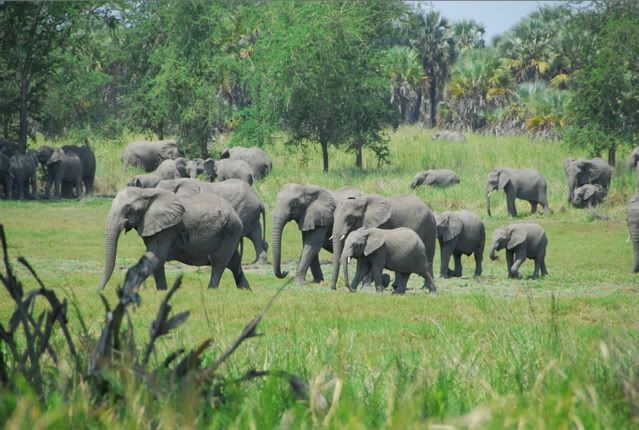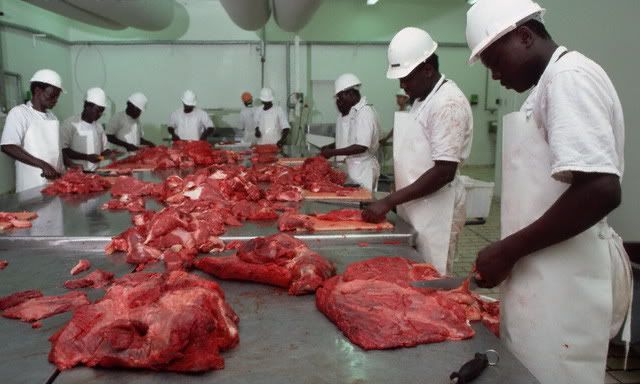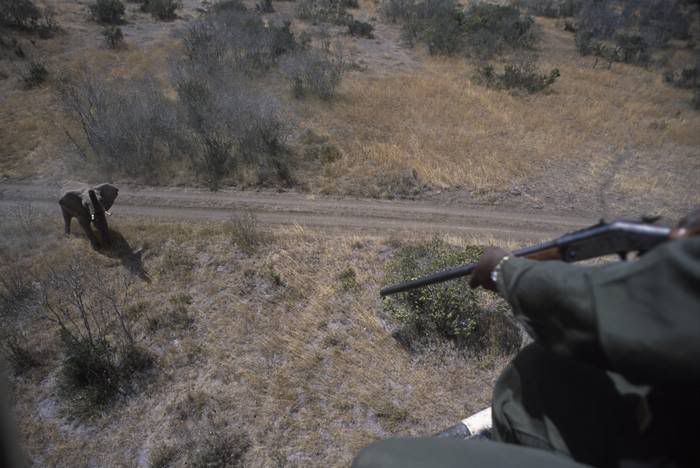My
desire to hunt and the resultant conservation benefits are not mutually
exclusive; they are actually inextricably linked. The net conservation benefit
has nothing to do with why I hunt, however these benefits are very
positive by-products of my hunting, a convenient truth. There will be some
greater good because of my quest to hunt the world's largest land animal.
So
what could lead to a need to kill elephant and how could such action possibly
have a positive outcome? Well there are a few things, and while we can
list them out for discussion, in reality they are intertwined in such a way
that each is a contributing factor to the other:
- Increasing populations;
- Boundaries in the modern world;
- Carrying capacity.
Increasing
populations
Successful
management of wildlife must be linked to the welfare of local communities. To
look after the people, the wildlife must be managed, and to assure the future
of Africa's mega fauna the needs of the communities that share their range must
be considered.
In
1950 the average family group in rural southern Africa had enough land to grow
more than enough food for themselves and were able to sell some of their
harvest to procure the things they couldn't produce. The typical piece of land
we’re talking about supported 8 people.
Animals
that roamed freely would come into contact with humans, particularly along the
edges of parks and reserves, but the conflicts were limited and fatalities on
both sides reflected that. Opportunistic elephant would raid crops but the
situation was tolerable.
In
2010, that same piece of land is supporting 60 people, with a documented
doubling of the population every 20 years. That same piece of land is now under
immense pressure in terms of food production.
As
the intrinsic poverty of a community increases, the people will do whatever is
necessary to ensure that their basic needs are met. Killing animals for
meat puts food in people’s bellies. Killing elephant and rhino for ivory
and horn puts cash in people’s pockets – typically the ivory from an elephant
may put USD30.00 into the hands of a poacher. Yes, that’s thirty dollars.
Following
the ban on the ivory trade by the parties to the CITES Convention, the elephant
population has enjoyed a consistent growth of 5% per annum and today their
numbers are at their highest in modern history in spite of the terrible
poaching we saw in the '70s and '80s.
 |
| A consistent population growth of 5% per annum has seen elephant number reach all time highs in southern Africa. |
The tension between humans and wildlife is at an all time high in
wilderness areas all over the world. Human-animal conflict has reached
unprecedented levels for elephants in both Africa and India.
Humans are struggling to produce enough to feed themselves - the
impending global food shortage has made mainstream news quite a lot in recent
times - and elephants in unusually high numbers find the various fruit and
vegetable production areas irresistible. These small agricultural enterprises
have become a hot zone of human-animal conflict and whether it be crop raiding
elephants, predators preying on cattle and goats or attacks on people, there is
considerable resentment from rural African communities towards wildlife.
These feelings do not bode well for Africa's big game and without
creating some intrinsic value to the people; the future for wildlife may have
been bleak.
 |
| The abbatoir in Kruger Park processed meat resulting from culls. |
We’ve
created countries and provinces with cities and towns and highways. The great
migrations of yesteryear are more and more limited as humans prosper and
increase their range. With the increase in population comes the need for
greater infrastructure and employment and the much more complex systems
required in our modern lives.
Extensive
road networks and highways, railway lines for passengers and freight, growing
cities and suburbs, an ever increasing number of rural villages and more
agricultural activity at a larger scale than ever means that there is huge land
pressure in modern Africa.
As
humans encroach further on African wilderness areas, much of the wildlife in
these areas finds itself as either a victim of the illegal bush meat trade or
in the case of mega fauna and predators, in conflict with local communities and
their agricultural activities.
Cropping
activities are producing a far more palatable and nutritious food source than
is generally available on the edge of what may be very poor country or an
ecosystem that is failing under the burden of mouths to feed. So a crop, be it
onions or orchards is going to be a hotspot for elephant activity.
Whilst
raising livestock is an issue due to predators, there is a less obvious
connection with elephant. The Masai in Kenya, particularly around Amboseli
National Park are in constant conflict with lions but seemingly live in harmony
with the elephant; so localised land use also impacts the extent of human-animal
encounters and conflicts. In the northern reaches of South Africa along
the banks of the Limpopo River, elephants cross the riverine border from
Botswana and head south as they always have – but today they encounter
communities and agricultural activities that weren’t there before…
Carrying
capacity
Modern
man has done a lot of research into the carrying capacity of any given piece of
land to maintain a population of animals. In Australia, agricultural efficiency
has borne the concept of the dry sheep equivalent (DSE) where a parcel of land
is given a DSE value that indicates its sheep carrying capacity.
We
often struggle to do the same with our wildlife. The introduction of
significantly more watering points and improved pasture has given Australia’s
kangaroo species the opportunity to flourish in what is some of the most arid
country on earth. As a result large numbers of kangaroos are culled every year
under kill only or harvester tags.
I
have visited properties and had some involvement with culling operations where
kangaroos have been in plague proportions; swing the big Lightforce around the
paddock and you're met with hundreds of pairs of hungry eyes. It's worse when
conditions are poor and the mobs come out of the timbered country.
Although
not popular policy, the culling if kangaroos had been deemed necessary to
ensure good land management; left unchecked the kangaroo population would
implode, and in the short term, take our grazing industry along with it. At the
peak of our most recent drought in the summer of 2005 the bodies of 'roos, emus
and goats littered the paddocks as poor conditions and out of control animal
populations came to a head.
 |
| After the choppers and shooters finish their job, the hard work resulting from the elephant cull begins. |
In
Africa the elephant is in a similar conundrum. By the late eighties numbers had
been decimated due to ivory poaching, however when the poaching was stopped
through the ban on international ivory trade and harsh anti poaching efforts on
the ground, populations soon bounced back to today's record numbers.
Botswana's
estimated carrying capacity is some 5,000 elephant for the entire country - the
near 200,000 elephant roaming the country have stripped the woodlands and the
famous Chobe River is slowly failing as its banks, stripped of all vegetation,
are eroded into the flowing waters. Beautiful as it is, Botswana is an
environmental disaster.
Similarly
Kruger Park has an estimated carrying capacity of 4,000 elephant. Today's
population is at 16,000 elephant and climbing in this relatively small area and
95% of the top canopy trees have disappeared since 1960 as a result of this
gross overpopulation.
So
what does this all mean?
And
so we come to those heated discussions in bars and at dinner parties.
Emotion charged and nonsensical arguments against the killing of elephant for
any reason, with trophy hunting being a particularly abhorrent concept.
Most
of those opposed to the killing of elephant would revert back to "…let
nature take its course, elephants did just fine long before we got involved…"
People simply need to understand that those days are gone forever.
A
number of factors have been highlighted to explain the need for effective
wildlife management: Africa’s massive human population, elephant numbers at a
record high (and growing), limited opportunity for the movement of big game
across the continent - more so as time goes by - and a grossly unbalance
elephant population, far in excess of the carrying capacity of the land.
We
have forever altered the face of the earth and created an environment where the
majestic elephant, once free to migrate thousands of kilometres as food sources
were depleted, are confined to areas that can no longer support a population
that grows at current rates. Allowing "nature to take its course" in
these relatively small, isolated game reserves and national parks will have
devastating effects on not only the elephant population, but on all wildlife
populations within each biome. As we lose our trees so we will lose the
wildlife that depends on them and in the ever-decreasing spiral we will devalue
the soil and limit its future potential.
The
interactions and options for today’s elephants, the communities live in their
range and the land that they share are somewhat limited. Unchecked, elephants
will continue to strip their habitat, the human-animal conflict will continue
as the elephants continue to raid crops and compete for the limited resources
available and combined, all of these factors will increase poverty and lead to
more and more illegal poaching to provide food and a source of income to
communities under pressure.
Two
things need to be altered in order to make significant change to this system:
- Reduce the elephant population to reduce the pressure on their habitat, reduce demand on resources and reduce conflict where elephants enter agricultural zones; and
- Empower the communities who share their range and give them control with some guidance of the renewal resources that they must share their lives with, provide people with enough food to eliminate any need for illegal activity to feed their families and provide these people with an income so that they may gain some independence and better their situation now and for future generations.
Reducing
elephant populations to suit the carrying capacity of the land can do all of
this. Culling of elephants will have the most impact on the total population in
the shortest period of time and meets many of the requirements I noted above.
Although unpalatable to many, culling at a rate equivalent to the natural
attrition rate would save the habitat and provide vast amounts of meat to feed
starving communities.
Hunting
on the other hand has less impact on elephant numbers in the short term with
arguably a more favourable outcome. As with culling, elephant numbers
would be reduced and with that come all of the resultant benefits; clearly a
combined hunting and culling strategy would be more effective in this regard.
Hunting would also provide meat. The great benefit of hunting are the
large sums of cash that may be provided to communities in the concessions where
the hunting takes place.
Granting people control over their resources makes wildlife valuable to
local communities because they can see an economic and ecological return.
Communities empowered with the right to control natural resources may choose to
sell hunting concessions to private operators under rules and hunting quotas
established in consultation with the wildlife department. Income is
generated through hunting lease fees, daily rates, trophy fees, and sales
of ivory, horn, skins and meat.
Communities can receive the benefits of hunting on their concession and
distribute a portion of the monies to each household as a dividend, and keep
the balance to fund community programs to create employment, provide healthcare
and education or other relevant projects.
Notice that I didn’t say trophy hunting in that last spiel; reason being
that there is a place for non-trophy elephant hunt purely for the purpose of
reducing numbers and providing meat. While a sport hunter may not be
willing to pay the same amount for a tuskless cow, there is still plenty of
interest in such hunts and an opportunity to generate income.
 |
| This community live in a Big 5 hunting concession along the Kana River in Gwayi, Zimbabawe. I just provided a buffalo; the larder is full for now... |
And
ultimately, what is the point of all of this rambling? Those who live and
suffer the cost socially and economically and have the responsibility of
preserving as well as managing the natural resource concerned should receive
all potential benefits from the sustainable utilisation of that natural
resource.
To
this end, if hunters can get out there and enjoy the adventure of tracking and
stalking elephant, why not?








No comments:
Post a Comment